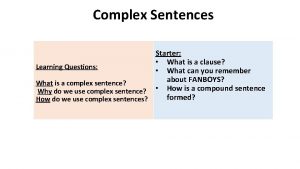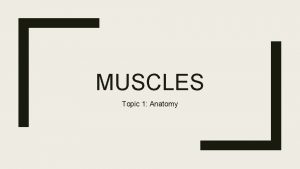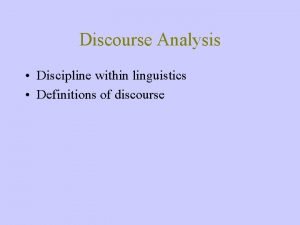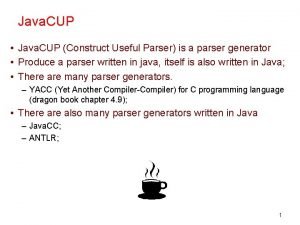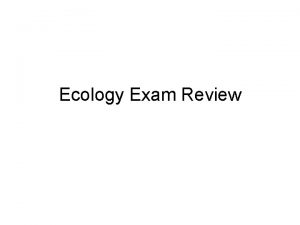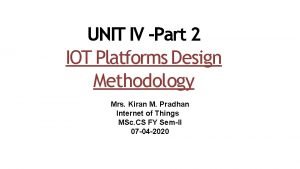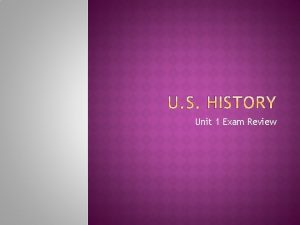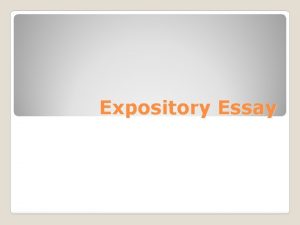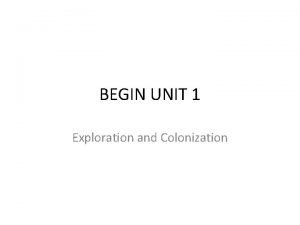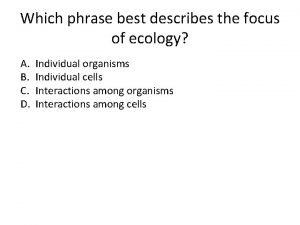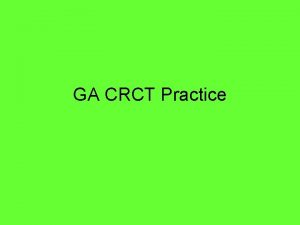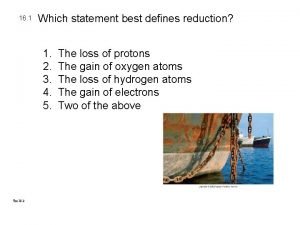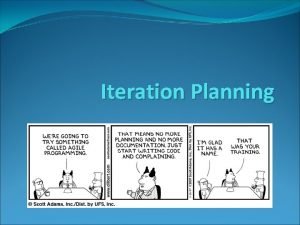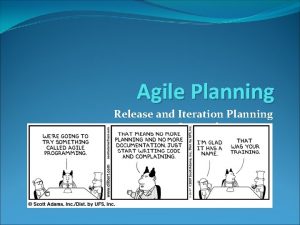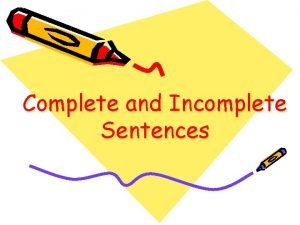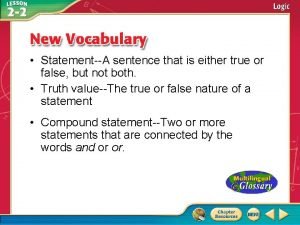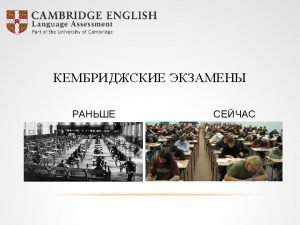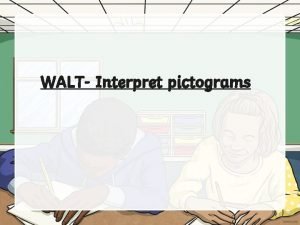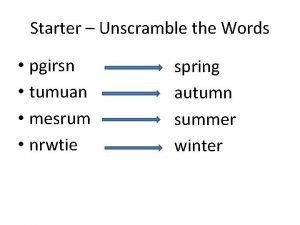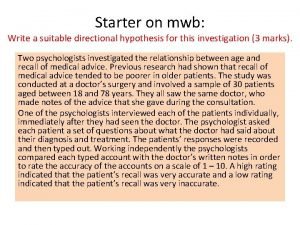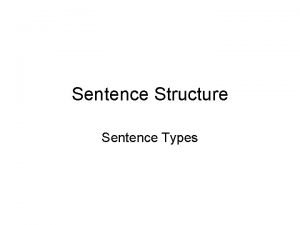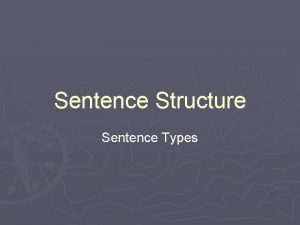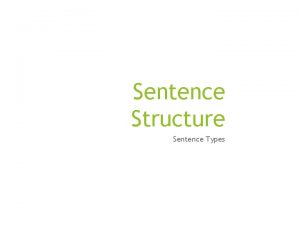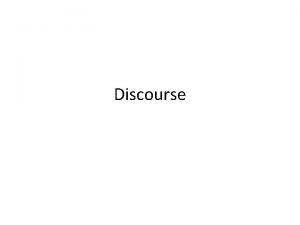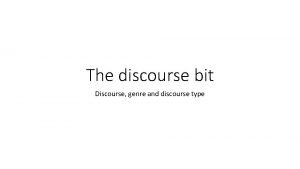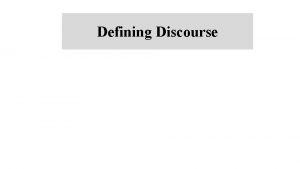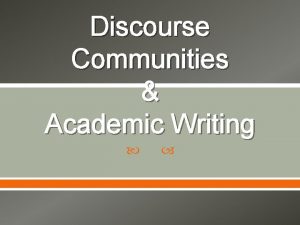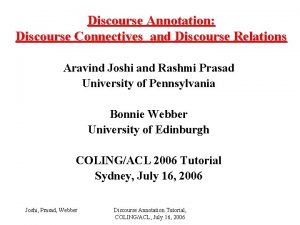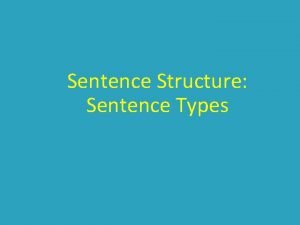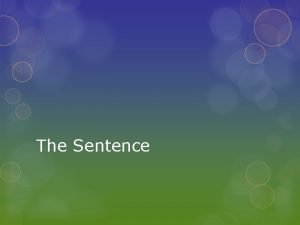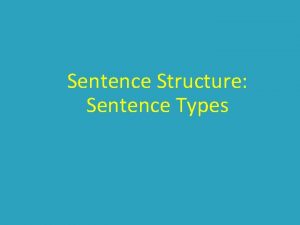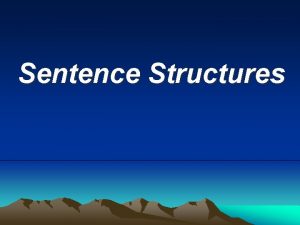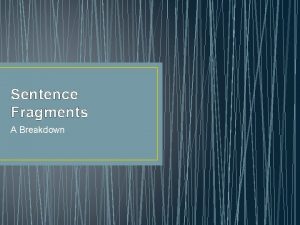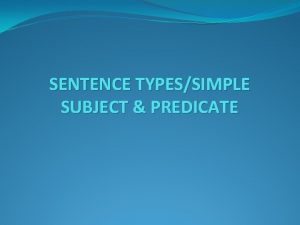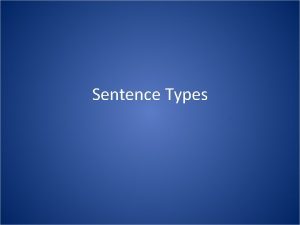Starter Write a sentence which defines what discourse






























- Slides: 30

Starter Write a sentence which defines what discourse is. Compare your sentence with the person sitting next to you.

Discourse and Cohesion

Discourse A stretch of language (spoken, written or multimodal (hybrid) considered in its context of use. This could be: instructions, articles, diaries, poems, Written examples are: • The discourse structure of an essay - it might have an introduction, the middle being the main essay, and then a conclusion. • A story - it might have a dramatic opening, build up to the climax, an exciting climax and finally a resolution

A discourse is a use of language in an attempt to communicate thoughts, ideas and feelings. A discourse – depending on its genre – will be made up from its user’s choices of: • the forms (i. e. the shapes and sounds of language – including mental imagery) • the structures of language. (i. e. grammar – the sequencing of words/phrases in a sentence; and ‘discourse structure’ the sequencing of sentences into the whole discourse itself). A discourse is any use of language between people. Thus all texts are examples of a particular kind of discourse and should be analysed as such. A discourse might be a conversation, a discussion, a letter, a novel, a newspaper article, or whatever - discourses are everyday and everywhere and have been in existence since language began.

When you discuss a text, it’s useful to label it as a particular kind of discourse, e. g. ‘…this text represents a discourse of early 21 st century broadsheet newspapers'; ‘…the discourse of 19 th century working men and women'; ‘…medical discourse'; ‘…doctorpatient discourse', ‘…teacher-pupil discourse', and so on. A discourse either is (most forms of written texts) or is intended to be (speech) ‘coherent’, that is intended to ‘follow on’ fluently, often in a form of ‘cause and effect’ sequence or structure. Many discourses – mostly those that are written – are also ‘unified’ and have a central controlling idea or ‘theme’ (a fictional narrative is a good example). Discourses are made coherent through the shared knowledge of the rules of grammar and the use of various linguistic devices such as pronouns, conjunctions, etc.

Discourse analysis is a way of analysing language to uncover not just the meanings and feelings intended to be conveyed but also to account for the pragmatic implications and other effects created by contextual aspects, including social, cultural and historical aspects. The latter include society’s prevailing ideologies, i. e. the ‘world view’ and cultural baggage we all carry around with us and which feeds into our language choices either consciously or otherwise. Ideologies are our social or cultural attitudes and values. A discourse analysis searches out not just what meanings and feelings are being conveyed but also looks at how this occurs and why. the attitudes and values language conveys either intentionally or otherwise. By examining a text for what it properly is – a social phenomenon or ‘slice of life’ - discourse analysis tries to expose important aspects of the creators and users of the text, of their society and culture – aspects well beyond that which the choices of words and grammar can ever show.

Discourse analysis A grammatical analysis – that is, analysis of the structure of a text’s words and sentences – reveals how syntax and morphology can be used to help convey meaning and feeling. Syntax = word order (e. g. subject + verb + object = SVO) Morphology = word form (e. g. un-interest-ing). A discourse analysis reveals how aspects of the writer, speaker and reader’s context, including their social or professional relationship and social and cultural ‘baggage’ are all a part of (and are thus can be made apparent) the text.

Semantics and Pragmatics Analysing a text requires you to. . . • Reflect on and carefully consider its context, i. e. viewing it as an example of once real social discourse. “Yobs are not sexy. Louts are not sexy men. The kind of man who says ‘get your coat, love, you’ve pulled’ is most definitely not sexy. But what is sexy is a man who acts like a gentleman - especially on a first date. “ From The Dating Game by Davina Mc. Call (2000). • Dissect its effective and important stylistic aspects, i. e. those aspects of language and language features that reveal the language user’s attempts to suit the text to a particular genre, context, audience and purpose. “Welcome to the one magazine guaranteed to make you an armed and dangerous woman. If you own a credit card and a handbag, then together with March GLAMOUR you have all the necessary tools to lay waste to all your favourite new collections. ” from Glamour Magazine, March 2002.

Discourse analysis Possible discourse analyses • A discourse that took place between you and a friend of the opposite sex this morning before school. • You could analyse it for what it shows about contemporary mixed gender conversation tactics. • A discourse that takes place in a news’ studio at the BBC. • You could analyse it for its use of politically correct language; or to discover if any prevailing ways of thinking – our society’s dominant ideologies – are being created or reinforced by the effects of this, very trusted, kind of discourse. • A discourse that took place in the mid-19 C between two factory owners. • You could analyse this as an example of ‘ 19 C male industrialist’s discourse’ for its reinforcement of patriarchal attitudes; or for its relative formality and high levels of politeness. • The discourse of editors’ letters taken from contemporary ‘lads’ mags’. • You could analyse these examples of ‘men’s magazine discourse’ for their use of sexualised ironic rhetoric.

Discourse analysis What discourse and stylistic aspects could you make of the following discourses 1. “Has the bell gone yet? I’ve got a Year 11 “Inspector Calls” next – how on earth am I gonna start that lesson? Hmmm. . . I’ll have to finish planning my language lesson before lunch and then get on with that overdue marking. ” 2. “What cut would you like, madam? Lean end of loin or best fillet? Just over half a kilo be enough? ”

The genre of Advertising - Discourse • Genre is an important aspect of discourse analysis. Some genres are genuinely authentic, others are ‘mock authentic’ (e. g. advertising copy). This this aspect through carefully – it’s a very important feature of discourse analysis – degrees of authenticity. • Advertising discourses can be good for practising discourse analysis. This is because they are designed to carry a pragmatically inferred connoted ‘cultural code’ that operates “below” the surface level of the denoted semantic meanings. • The ‘message’ of an ad is the product or service; this can easily be rejected. The ‘cultural code’ cannot: this expresses how life ‘needs to be lived’ if you are to be ‘normal’, ‘cool’, etc. . This is audience specific to some degree. The message and code are linked to suggest that one might lead to the other.

Task Read the advert. What do you notice about it? Is it cohesive? Why not?

REMEMBER: When looking at any text you must consider: The Text Producer (Author) The Text Receiver (Reader/Audience)

Types of texts: Fictional prose, adverts, instructions, arguments, news articles, prepared speech and conversation, analysis / argument, media ads, instructions, recipes, and personal / business letters. Narrative structure relies on the sequencing of events to create an unstated revelatory plot. Expository structure is a sequencing of sub topics used to clarify or argue for a stated overarching topic / controlling idea. Think about the semantic / affective (emotional) implications of the two structures. Examples of expository texts include: scientific journals, guides

Types of Writing NARRATIVE EXPOSITORY Tells a story Gives information Focuses on one moment or day in time. Author gives reasons and examples to support the thoughts and information they are writing about This is where you will see moments explode, show not tell, etc. The same prompts can be used for both narrative and expository writing. How you write it is the only thing that changes. Author’s Purpose: To entertain Author’s Purpose: To inform Reader’s Purpose: To be entertained Reader’s Purpose: To learn or be informed

Homework task 1. Conduct personal research into narrative and expository texts. 2. Revise the language level ‘DISCOURSE’ using the resources you have been given.

1. Abstract - How does it begin? 2. Orientation - Who/what does it involve, and when/where? 3. Complicating Action - Then what happened? 4. Resolution - What finally happened? 5. Evaluation - So what? 6. Coda - What does it all mean? Labov’s narrative categories Res on i t c a ing olut at c i l p Com ion EVALUATION Orie nta a Cod tion Abstract

Part 2: The Social Discourse of Change

Social Discourse • Social discourse looks at the ideologies being promoted in a text. • It looks at the social use of language and the attitudes people/society/cultures have. • It can reveal the belief systems of the day, the way people lived their lives, what their world view is/was and it can reveal how constraining society was at the time. A newspaper article can persuade others to think the same way as yourself.

Always consider this … If it is in our thoughts, it will be in our language

Text A is from the Daily Mail newspaper, printed in 1923. It is a report about the Royal Wedding of Lady Elizabeth Bowes-Lyon (our late Queen Mother and mother to our present Queen Elizabeth II) and the King’s son, the Duke of York. It is the first Royal Wedding since the end of the First World War (1914 - 1918) Text B is from the Guardian online, posted in 2011. It is a report about the Royal Wedding of Prince William (Grandson of our present Queen Elizabeth II) and Kate Middleton. There had been negative press reports about how much the wedding will cost tax payers in policing and security leading up to the wedding. There has also been debate in the media about the future of the Royal Family in modern times, as well as whether, in the 21 st century, any public interest would be generated by the marriage. The Guardian is a traditionalist newspaper.

The Royal Weddings How do you remember the Royal Wedding of Prince William and Kate Middleton being reported/some of the topics it brought about? Tick yes/no: Promotion of Britain and ‘Britishness’ Link to fairy tales Where they will live as a married couple Children Marrying a commoner The cost of the wedding to the tax payer Whether we should have a national holiday Whether we should have a Royal family

2011 Guardian article Headline and subheading 1923 Daily Mail article Headline and subheading Opening paragraph How it moves on in sub-topics Lexis that encapsulates a modern world Lexis that encapsulates an older time Summary of differences to the 1923 article Summary of differences to 2011 article

Which topics from that chart would not have been written about at the marriage of King George VI and his bride Lady Elizabeth Bowes-Lyon (the Queen Mother who has now passed away)? Why do you think this is and what do you think has happened to make the social discourse of modern Royal family reporting different to latter day Royal family reporting?

1923 v 2011 Royal Weddings Reading for social discourse is a subtle activity. Don’t take any words in your own vocabulary for granted. For instance ‘mini-coach’ (or mini-bus’ as it would be called by the majority), would not be a word found in the 1923 wedding. Not only this, but the concept of the royal family being ‘bundled’ into a vehicle often thought of as ‘party buses’ for hen nights etc. would simply not be acceptable!

Systematically pick texts apart Discourse structure and social discourse can be discovered and written about cleverly by one simple task … Cover everything except the heading and sub-heading in the 2011 article. What issues stand out? Do the same for the 1923 article. Next, cover everything except the first paragraph in the 2011 article. What theme does it begin the article with? Do the same for the 1923 article. While you’re looking at the discourse structure (how the article moves on in theme, look for words, expressions and themes that would not be used in the other text. Work in pairs to complete your handouts. Get ready to discuss

Essay writing practice Imagine this is the discourse part of a fuller essay. Write a maximum of two paragraphs, deeply bringing out the discourse (social & structure) in the two articles of the Royal Weddings.

Recap What assessment objectives is being hit with a discourse structure and social discourse discussion? While you’re analysing the discourse, what other framework can you also be analysing? Lexis (and semantics) What must you read to help you gain some context around each text? ? The smallprint!

What are the main four reasons why language changes? • Economy • More egalitarian society • Media • technology

What particular social events have changed our language? • Blurring of the class structures • Education became wider among different social classes • Introduction of public broadcasting • Prolific rise of film and video • Popular youth culture
 What is discourse analysis
What is discourse analysis Complex sentence starter
Complex sentence starter Starter which muscles do you already know
Starter which muscles do you already know Discourse in a sentence
Discourse in a sentence Discourse analysis definition
Discourse analysis definition Conclusion of cold chain
Conclusion of cold chain Java_cup
Java_cup Which phrase best describes the focus of ecology
Which phrase best describes the focus of ecology Process specification in iot design methodology
Process specification in iot design methodology Which statement best summarizes chapter 11
Which statement best summarizes chapter 11 Leader development marines
Leader development marines Which type of essay explains informs defines
Which type of essay explains informs defines Which statement best defines the term civil liberties?
Which statement best defines the term civil liberties? Which phrase best describes the word ecology?
Which phrase best describes the word ecology? Which statement best describes apartheid
Which statement best describes apartheid Which statement best defines a cell
Which statement best defines a cell Which of the following is not an employability skill
Which of the following is not an employability skill Answer
Answer What is meant by an iteration goal
What is meant by an iteration goal Which statement best defines cold chain management
Which statement best defines cold chain management How is a tundra biome similar to a desert biome? *
How is a tundra biome similar to a desert biome? * 5 levels of planning agile
5 levels of planning agile Off topic sentences
Off topic sentences Sentences with complete
Sentences with complete A sentence that is either true or false
A sentence that is either true or false Flyers movers starters ages
Flyers movers starters ages Pictogram starter
Pictogram starter Reichstag fire who was the fire starter
Reichstag fire who was the fire starter Mesrum
Mesrum Hypothesis starter
Hypothesis starter Starter background
Starter background

